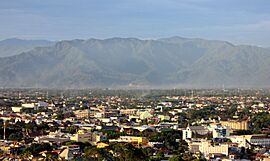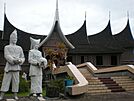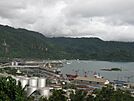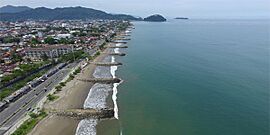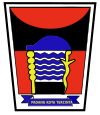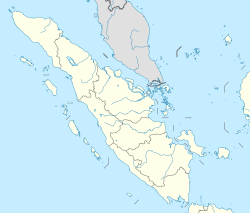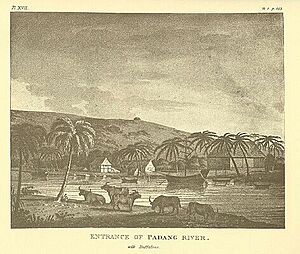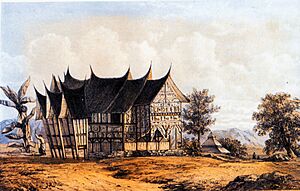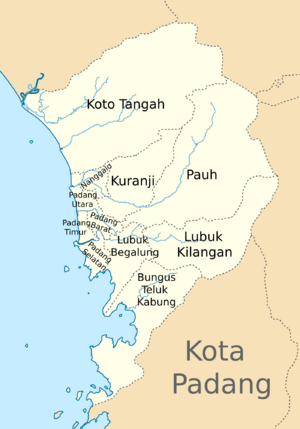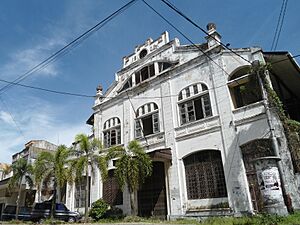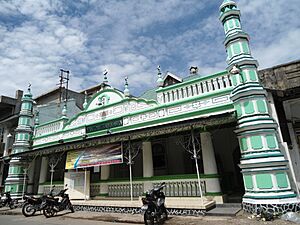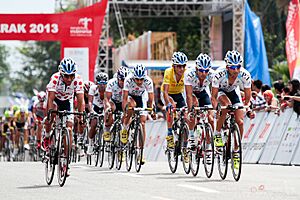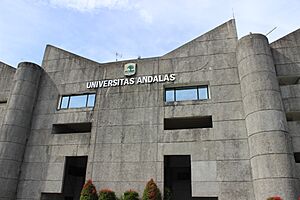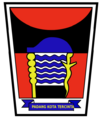Padang facts for kids
Quick facts for kids
Padang
|
||
|---|---|---|
|
City
|
||
| City of Padang Kota Padang |
||
| Other transcription(s) | ||
| • Jawi | ڤادڠ | |
|
Clockwise from top:
|
||
|
||
| Motto(s):
Padang Kota Tercinta
(Padang, a Lovely City) |
||
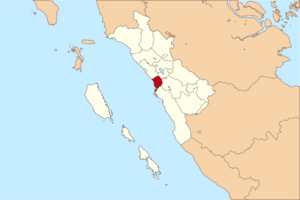
Location within West Sumatra
|
||
| Country | ||
| Region | Sumatra | |
| Province | ||
| Founded | 7 August 1669 | |
| Incorporated | 1 April 1906 | |
| Area | ||
| • Total | 694.96 km2 (268.33 sq mi) | |
| Elevation | 0–1,853 m (0–6,079 ft) | |
| Population
(mid 2023 estimate)
|
||
| • Total | 942,938 | |
| • Density | 1,356.823/km2 (3,514.157/sq mi) | |
| Demonym(s) | Padangnese | |
| Time zone | UTC+7 (WIB) | |
| Area code(s) | +62 751 | |
| Climate | Af | |
| HDI (2022) | ||
Padang is the capital and largest city in the West Sumatra province of Indonesia. It's located on the west coast of Sumatra island. In mid-2023, about 942,938 people lived there. This makes it the 16th most populated city in Indonesia.
Padang is famous for its unique Minangkabau culture, delicious food, and beautiful sunset beaches. For a long time, even before colonial times, Padang was an important trading hub. People traded things like pepper and gold here. The Dutch arrived in the mid-1600s and eventually took control of the city. Padang became a major city in the Dutch East Indies until Indonesia became independent.
Contents
History of Padang
![]() Dutch East India (1663–1781)
Dutch East India (1663–1781)
![]() British Empire (1781–1784)
British Empire (1781–1784)
![]() Dutch East India (1784–1795)
Dutch East India (1784–1795)
![]() British Empire (1795–1819)
British Empire (1795–1819)
![]() Dutch East Indies (1819–1942)
Dutch East Indies (1819–1942)
![]() Japanese occupation (1942–1945)
Japanese occupation (1942–1945)
![]() Republic of Indonesia (1945–present)
Republic of Indonesia (1945–present)
Padang has been a busy trading center since the 1500s. It was once controlled by the Pagaruyung Kingdom and the Aceh Sultanate. In the 16th and 17th centuries, people grew and traded pepper with countries like India, Portugal, the UK, and the Netherlands.
In 1663, the Dutch took over Padang and built a trading post in 1680. The British Empire controlled the city twice: first from 1781 to 1784, and again from 1795 to 1819. In 1819, Padang was given back to the Netherlands. Until about 1780, gold from local mines was the most important trade item. After the gold mines ran out, people started trading other goods like coffee, salt, and textiles.
Natural Disasters in History
Padang has experienced large natural events. In 1797, a huge tsunami hit the city after a strong earthquake. The tsunami waves were very high, washing away houses and causing some deaths. Boats in the Arau river were even carried far inland. Another tsunami hit in 1833 after another strong earthquake. This also caused damage and scattered boats.
In 1837, the Dutch government made Padang the main city for the West Coast of Sumatra. Padang officially became a "city" (gemeente) on April 1, 1906. Before World War II, Padang was one of the five biggest port cities in Indonesia.
By 1920, Padang had about 28,754 people, making it Sumatra's second-largest city. When Indonesia gained independence in the 1940s, Padang had around 50,000 residents. Coffee was still important, but copra (dried coconut meat) also became a major product. Since then, Padang's population has grown a lot, partly because the city expanded and partly due to people moving from rural areas to big cities.
When the Japanese army arrived on March 17, 1942, the Dutch left Padang. The city was then used by the Japanese as an administrative center during their control of West Sumatra.
On September 30, 2009, a strong earthquake hit near Padang. More than 1,100 people died, with 313 deaths happening in Padang itself.
Geography of Padang
Padang is located on the west coast of Sumatra island. Its total area is about 694.96 square kilometers. More than 60% of Padang's area is made up of hills covered by forests. Only about 205 square kilometers is an urban area where people live. The hills are mostly in the east and south of the city. Some well-known hills include Lampu Hill and Mount Padang.
Padang has a coastline of about 68 kilometers along the mainland of Sumatra. There are also 19 small islands nearby, such as Sikuai Island and Toran Island.
Climate and Weather
Padang has a tropical rainforest climate. This means it's usually hot and very wet all year round. Padang is one of Indonesia's wettest cities, getting about 4300 mm of rain each year. Even in its driest month, February, it still gets about 250 mm of rain. The temperature stays pretty much the same throughout the year, averaging around 26 degrees Celsius.
Padang has 21 rivers. The longest one is Batang Kandis, which is 20 km long. In 1980, two-thirds of the city was flooded because the drainage system couldn't handle all the water.
| Climate data for Padang | |||||||||||||
|---|---|---|---|---|---|---|---|---|---|---|---|---|---|
| Month | Jan | Feb | Mar | Apr | May | Jun | Jul | Aug | Sep | Oct | Nov | Dec | Year |
| Record high °C (°F) | 33.9 (93.0) |
34.4 (93.9) |
33.9 (93.0) |
33.3 (91.9) |
33.9 (93.0) |
33.9 (93.0) |
33.3 (91.9) |
33.3 (91.9) |
32.8 (91.0) |
33.3 (91.9) |
32.8 (91.0) |
32.8 (91.0) |
34.4 (93.9) |
| Mean daily maximum °C (°F) | 30.6 (87.1) |
31.7 (89.1) |
31.7 (89.1) |
31.7 (89.1) |
32.2 (90.0) |
32.2 (90.0) |
31.7 (89.1) |
32.2 (90.0) |
32.2 (90.0) |
31.7 (89.1) |
31.1 (88.0) |
30.6 (87.1) |
31.6 (88.9) |
| Daily mean °C (°F) | 27.0 (80.6) |
27.0 (80.6) |
27.0 (80.6) |
27.2 (81.0) |
27.5 (81.5) |
27.0 (80.6) |
25.0 (77.0) |
25.0 (77.0) |
26.7 (80.1) |
26.7 (80.1) |
26.7 (80.1) |
26.7 (80.1) |
26.6 (79.9) |
| Mean daily minimum °C (°F) | 23.3 (73.9) |
24.4 (75.9) |
23.9 (75.0) |
23.9 (75.0) |
23.9 (75.0) |
23.9 (75.0) |
23.3 (73.9) |
23.3 (73.9) |
23.9 (75.0) |
23.9 (75.0) |
23.9 (75.0) |
23.9 (75.0) |
23.8 (74.8) |
| Record low °C (°F) | 21.1 (70.0) |
20.6 (69.1) |
21.1 (70.0) |
21.7 (71.1) |
21.7 (71.1) |
20.0 (68.0) |
21.1 (70.0) |
20.6 (69.1) |
21.1 (70.0) |
21.1 (70.0) |
21.1 (70.0) |
21.1 (70.0) |
20.0 (68.0) |
| Average precipitation mm (inches) | 351 (13.8) |
259 (10.2) |
307 (12.1) |
363 (14.3) |
315 (12.4) |
307 (12.1) |
277 (10.9) |
348 (13.7) |
352 (13.9) |
495 (19.5) |
518 (20.4) |
480 (18.9) |
4,172 (164.3) |
| Mean monthly sunshine hours | 175 | 181 | 175 | 188 | 200 | 206 | 200 | 186 | 136 | 135 | 167 | 167 | 2,116 |
| Source 1: Sistema de Clasificación Bioclimática Mundial | |||||||||||||
| Source 2: Deutscher Wetterdienst (sun, 1961–1990) | |||||||||||||
City Government and Districts
| Historical population | ||
|---|---|---|
| Year | Pop. | ±% |
| 1819 | 8,500 | — |
| 1874 | 25,000 | +194.1% |
| 1920 | 28,754 | +15.0% |
| 1930 | 40,744 | +41.7% |
| 1961 | 143,699 | +252.7% |
| 1971 | 350,277 | +143.8% |
| 1980 | 480,922 | +37.3% |
| 1990 | 631,263 | +31.3% |
| 2010 | 833,562 | +32.0% |
| 2020 | 909,040 | +9.1% |
| 2023 | 942,938 | +3.7% |
The city of Padang is led by a Mayor. The local government has introduced some policies related to community practices. For example, female city employees and students in government schools are encouraged to wear jilbab (a head covering). High school students also take classes on reading the Qur'an.
Administrative Districts
Padang is divided into eleven main areas called kecamatan (districts). Each district has its own administrative center and a number of smaller villages. The table below shows the size and population of each district.
| Name of District (kecamatan) |
Area in km2 |
Pop'n 2010 Census |
Pop'n 2020 Census |
Pop'n mid 2023 estimate |
Admin centre |
No. of villages |
Post codes |
|---|---|---|---|---|---|---|---|
| Bungus Teluk Kabung | 100.78 | 22,896 | 27,408 | 28,788 | Pasar Laban | 6 | 25237 |
| Lubuk Kilangan | 85.99 | 48,850 | 57,489 | 60,614 | Bandat Buat | 7 | 25231 - 25237 |
| Lubuk Begalung | 30.91 | 106,432 | 122,593 | 128,453 | LKubuk Begalung | 15 | 25221 - 25227 |
| Padang Selatan | 10.03 | 57,718 | 60,996 | 62,333 | Mata Air | 12 | 25211 - 25217 |
| Padang Timur | 8.15 | 77,868 | 77,755 | 78,407 | Simpang Haru | 10 | 25121 - 25129 |
| Padang Barat | 7.00 | 45,380 | 42,957 | 43,200 | Purus | 10 | 25111 - 25119 |
| Padang Utara | 8.08 | 69,119 | 55,171 | 55,484 | Lolong Belanti | 7 | 25132 - 25139 |
| Nanggalo | 8.07 | 57,275 | 58,535 | 59,240 | Surau Gadang | 6 | 25142 - 25147 |
| Kuranji | 57.41 | 126,729 | 146,111 | 153,137 | Pasar Ambacarng | 9 | 25151 - 25159 |
| Pauh | 146.29 | 59,216 | 62,228 | 63,489 | Pasar Baru | 9 | 25161 - 25168 |
| Koto Tangah | 232.25 | 162,079 | 197,797 | 209,793 | Lubuk Buaya | 13 | 25171 - 25176 |
| Totals | 694.96 | 833,562 | 909,040 | 942,938 | 104 |
Adipura Award
Padang has won the "Adipura" award many times. This award recognizes cities for being clean and green. As of 2017, Padang had won it 18 times in the large city category and the "Adipura Kencana" award three times.
Culture and Food
Delicious Padang Cuisine
The food of the Minangkabau people is known as Padang cuisine. You can find Padang restaurants all over Indonesia. They are famous for their spicy dishes!
In a Padang restaurant, food is usually cooked once a day. All the dishes are displayed, and you choose what you want. You only pay for the dishes you eat. One of the most famous Padang dishes is rendang, which is a spicy meat stew. For breakfast, many locals enjoy Soto Padang, a crispy beef soup. In the evening, sate (beef satay with curry sauce and ketupat) is a popular treat.
Things to See and Do
Padang is a popular stop for surfers heading to the Batu Islands and Mentawai Islands. It's also a starting point for tourists visiting the highlands of West Sumatra.
Padang Beach, also called Taplau, is famous for its beautiful sunsets and many food stalls. The Kuranji River flows through Padang, and its upper parts are great for white water activities. Bungus Bay, south of Padang, is perfect for swimming and boating. There are also islands nearby like Sikuai Island and Pagang Island.
The city government is working to make the "Padang Old City" area a special tourist spot. This area has 73 historic buildings that are now protected as cultural heritage sites.
Famous Landmarks
Padang has many old buildings that show Dutch and Chinese architecture styles. The old city, located by Muaro Harbor at the Arau River, used to be the main business area. Here you can find important buildings like the old Padang City Hall and the former De Javasche bank.
Some other historic places include:
- Adityawarman Museum: This museum focuses on the history and culture of the local Minangkabau people. Its main exhibits are in a building designed like a traditional Rumah Gadang house.
- Grand Mosque of West Sumatra: A large, modern mosque built with traditional Minangkabau architecture.
- Ganting Grand Mosque: The oldest mosque in Padang and one of the oldest in Indonesia, it's a popular place to visit.
- Masjid Muhammadan: A historic mosque founded by Indian merchants.
- St. Leo Monastery: This church combines traditional Minang architecture on its bell tower with Dutch architecture on the main building.
- Vihara Buddha Warman: A Buddhist Temple opened in 2006 for the city's large Chinese Buddhist community.
Beaches and Parks
- Air Manis Beach: Located 10 km south of Padang, this beach is famous for the legendary Malin Kundang Stone. You can see rock formations that look like shipwrecks here.
- Siti Nurbaya Park: Across from the Arau River, you can reach this park by bridge or boat. It has remains of Japanese cannons and bunkers from World War II. From here, you get great views of Padang city, the Arau River, and the Indian Ocean.
- Bung Hatta Nature Reserve (Taman Hutan Raya Bung Hatta): About 18 km east of the city, this reserve is home to diverse plants and animals. You might find Sumatran tigers, tapirs, wild goats, and bears, as well as unique flowers like Raflesia Gaduansi.
Sports in Padang
Padang is home to the football team Semen Padang F.C.. Their home stadium is Haji Agus Salim Stadium. Padang also hosts an annual international professional road bicycle race called the Tour de Singkarak. The city has also hosted the International Traditional (Dragonboat) Festival.
Media and News
The oldest newspaper in Padang is Harian Haluan. Other newspapers like Padang Ekspres and Pos Metro Padang are also available.
Padang TV is a local TV station based in the city. The public TV station TVRI West Sumatra also covers the area.
City Infrastructure
Public Transport
Padang has a bus rapid transit service called TransPadang. It's similar to Jakarta's TransJakarta system. It runs from Lubuk Buaya to Pasar Raya, covering a distance of 18 km. The service uses large and medium-sized buses.
Airport
The city is served by Minangkabau International Airport, located in Ketaping. This airport replaced the older Tabing Airport, which is now used as a military base. The airport has one terminal for both international and domestic flights. It has modern facilities like aerobridges and check-in counters. The runway was extended in 2013 to handle larger planes like the Boeing 747. There's also a train service connecting the airport to the city center.
Seaport
Padang's Teluk Bayur harbor (formerly Emmahaven Port) is the largest and busiest harbor on Sumatra's west coast. It handles both inter-island and international shipping. It was built in 1888 by the Dutch. In 2013, a new container terminal was opened, which can hold over 4,000 containers. The port is the main way to reach the Mentawai islands. You can also find ferry connections from Padang to Jakarta and Sibolga.
Toll Road
A new 28-kilometer toll road is being built between Padang and Sicincin district. This is part of a larger 244-kilometer toll road project connecting Padang and Pekanbaru. Construction officially began in February 2018.
Railroad
Railroad tracks connect Padang to other cities like Pariaman (north), Padangpanjang (northeast), and Solok and Sawahlunto (east). The biggest train station is Padang Station, also known as Simpang Haru station. Train services like Sibinuang and Dang Tuanku connect Padang to Pariaman.
Tsunami Shelter
The government and people of Hill Pangilun have agreed to use Mount Pangilun as a tsunami shelter. Roads to the hill will be improved, and temporary shelters with facilities will be built there.
Education in Padang
Padang has several universities and colleges. Two of the main ones are Andalas University and the State University of Padang. Andalas University is the oldest university in Indonesia outside of Java. Its main campus is about 12 km from the city center.
Other universities in Padang include Imam Bonjol State Islamic University, Padang Technology Institute, and Bung Hatta University.
| Formal education | Elementary School (SD) or Madrasah Ibtidaiyah (MI) | Junior High (SMP) or Madrasah Tsanawiyah (MTs) | Senior High (SMA) or Madrasah Aliyah (MA) | Vocational High School (SMK) | College or University | ||||||
|---|---|---|---|---|---|---|---|---|---|---|---|
| Quantity | 477 | 129 | 59 | 42 | 58 | ||||||
| Data sekolah di Kota Padang Source: |
|||||||||||
Sister Cities
Padang has special partnerships with other cities around the world, known as "sister cities":
Images for kids
See also
 In Spanish: Padang para niños
In Spanish: Padang para niños


